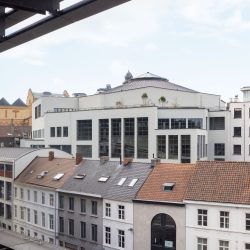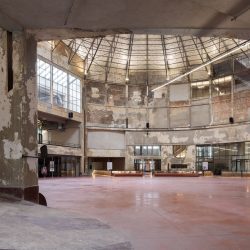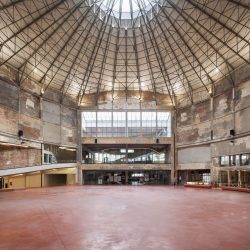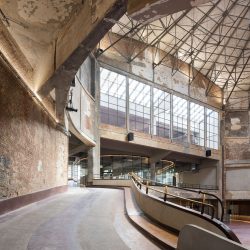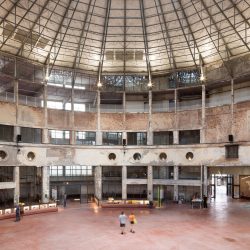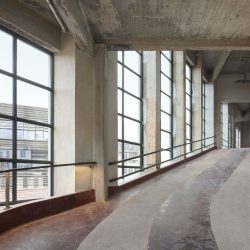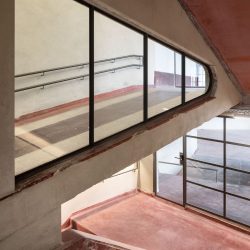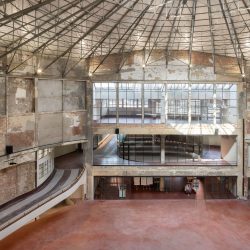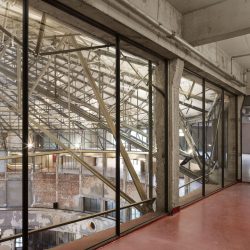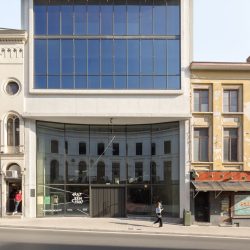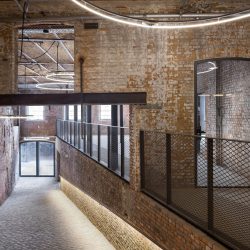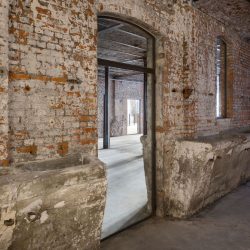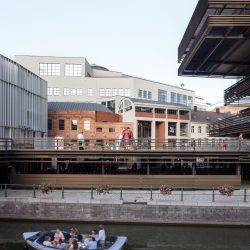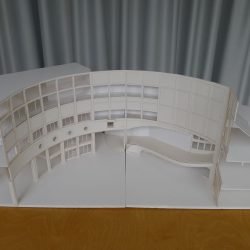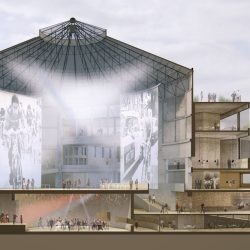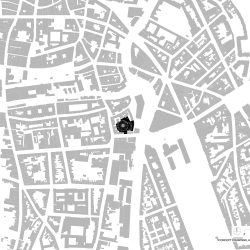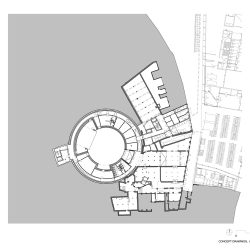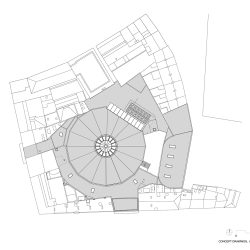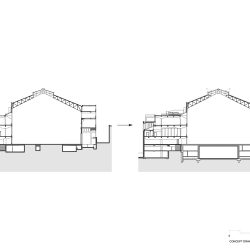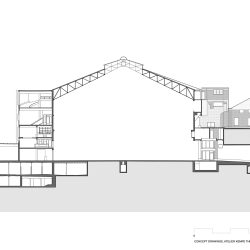
ATELIER KEMPE THILL . aNNo architecten . photos: © Ulrich Schwarz
From the very beginning, right through its turbulent history, the Wintercircus in Ghent has always been a composite of a real ring circus and a series of service buildings, all of which completely blend into the nearby buildings of an urban block in the Waalse Krook neighborhood. The first circus – conceived by architect Emile de Weerdt and built in 1894 on the site of a cotton factory that was destroyed by fire in 1920 – already followed this logic. The second circus – which was designed by Jules Pascal Ledoux, opened in 1923 and offered cinema and music events in addition to circus performances – anchored the circus even more firmly in the city thanks to elements such as the main entrance on Lammerstraat. Next to the actual circus building, there was a manège ring for exercising the horses and a stable to accommodate the elephants and other animals, including a separate logistics access from Platteberg close to the water. This “Nouveau Cirque” closed its doors in 1944.
A hidden world
Three years later, Ghislain Mahy, a car dealer and passionate collector of classic cars, bought the building complex after already having opened a Fiat garage there in 1939. In the 1950s, he began to transform and carry out major extensions along the periphery of the main ring circus building, including a showroom on Lammerstraat in a modern style – the only evidence of modernist architecture on the exterior.
Buying a car here was not only a pragmatic act but a minor event. Customers could enjoy the big atrium, go to the hairdresser that was directly adjoined to Mahy’s firm or fill up their car at Mahy’s gas station in the building. And what was even more remarkable: visitors could take a look at Mahy’s growing collection of classic cars that would become the world’s largest of its kind. The Mahy family closed the garage in the 1970s, but the classic car collection remained there until 2000 in newly extended spaces in the building complex. In the end, the collection had an amazing 950 vintage cars and trucks.
Invisible modernism
Ghislain Mahy’s makeover of the circus building complex is impressive in many respects. He first made the radical decision to remove the wooden grandstand inside, with stucco ornamentation and a false ceiling, and reduce the main round building to its bare concrete framework. As a result, he unveiled a massive atrium, an empty space that would serve as the focal point of his activities. Afterwards, step by step, he added ramps and new extensions inside and outside the main volume, basically to make all of the floors accessible for his cars. Due to the complicated setting in the city center and the rather complex topography and connections to the existing city, a real systematic and clear approach was impossible. Instead, the entire complex became a kind of Merzbau, at first glance a messy and simultaneously phantasmic collage, evoking the works of German Dada Artist Kurt Schwitters in the 1920s. Mahy made simple extensions where possible, in such a way that it always resulted in unexpected beauty. Indeed, he didn’t pay much attention to minimum heights or the curve radius or the steepness of ramps. Nor did he take legal matters, such as building permits, very seriously either. In fact, some of his projects were only regularized after having been completed. Instead, he concentrated all his efforts on creating sensible connections that would best serve all of the activities in the building. He used the spaces in a situationist manner that befitted them, creating a rich variety of views and light situations, lovely small booths and counters, and surprising and elegant details in the windows, plinths and concrete works. Although not a professional architect, he still seems to have been a talented designer and a consistent modernist in heart. All of the transformations, extensions, spaces, and details he added to the building show an enormous love for building in an elegant, modernist way, which – together with the enormous atrium – results in a nearly breathtaking experience.
His anarchistic way of building extensions led to crazy situations, such as borders with neighboring buildings that are different in the basement than in the upper floors or the fact that parts of the building reach under the public domain of the street. He solved substantial technical problems, such as the danger that the entire complex would start to slide into the water of the Muinkschelde, by fixing the whole complex with a gigantic concrete pole at a strategically well-chosen and hidden place.Some of the spaces also remained unused by Mahy, especially the former stables for the circus animals in the lower floors. Interestingly, even after the current renovation – 80 years after the last animals had left – the smell of animal still pervades the space.
Mahy’s entire operation seems to mirror the Flemish mentality: being modern goes hand in hand, without there being any conflict whatsoever, with a penchant for the small scale. This seems to originate from an age-old spirit of craftsmanship and a nearly fetishistic love for detail. And all of this takes place in a location completely closed off from the city, hidden in a block. Those entering the old circus building are treated to an overwhelming spatial surprise when confronted by its unexpected monumental scale.
A new life
In 2000, the car collection was moved to other locations and the building was abandoned. As a result, it fell into disuse and developed several problems, such as leaks in the roofs and façades, animals entering the building or intrusions by youngsters. Commissioned by the city of Ghent, the building was bought by the urban development company sogent in 2005 with the intention of renovating it while respecting its rich heritage. A competition was held by sogent to find an architect to transform the project and prepare it for a new life, which was won by Atelier Kempe Thill and aNNo architects in 2012. The intended program was a rock music hall for 500 spectators, a library for blind people, the Flemish archive for media VIAA, and the IT firm icubes. The building doesn’t have actual monumental status, but it is part of the protected streetscape of the urban environment. Still, the transformation of the interior needed to be discussed and agreed upon with the monument protection committee.
Four features by the Atelier Kempe Thill + aNNo design team
The first main design feature concerns the former circus space: this space is enormous and has the dimensions of a public square. In fact, it has the same huge dimensions of the Pantheon in Rome. Instead of filling it with a program or an additional built volume, the team at Atelier Kempe Thill proposed that it should be preserved as is and remain entirely empty. It will serve as a flexible public space, a kind of covered square for all kinds of activities connecting three sides of the city and the new library building De Krook from RCR / Coussée Goris Huyghe architecten on Platteberg. This concept gives the building its backbone, its authenticity, a relaxed generosity and preserves the sensation of discovering its monumental scale when entering the building.
The second main feature concerns the acoustically challenging rock concert hall. This is located in the underground, directly in the round main circus building in a concrete housing construction to prevent sound leakage to neighboring buildings and to completely separate the logistics from the rest of the building.
The third main feature concerns the finishing after the renovation: it was decided to keep the rough appearance of the unplastered brick walls and the big atrium space, where the plaster had partly fallen off during the years when it was abandoned, as well as the red painted concrete floors. This decision introduces a certain roughness and an unfinished character and leaves the patina of its historical development intact, as well as some of its decay. This approach largely contributes to the authentic character of the completed project, creates coherence and introduces a relaxed and sublime appearance. And it also makes it possible to stay within the low budget.
The fourth main feature has the crucial task of dealing with all of Ghislain Mahy adaptations. How should an architect approach this sensitive architecture, which represents great intrinsic value and quality? The team was mesmerized by the beauty and logic of these elements and decided to design with great modesty and empathy and, above all, respect the existing details to the greatest extent possible.
Situationist design approach
To adhere to these four self-imposed guidelines as strictly as possible, the team developed a specific design approach. All necessary programmatic adaptations, as well as all transformations related to fire regulations, acoustics and so on, were designed so they would have only a limited impact on the existing architecture and try to preserve its authenticity. The team didn’t look for contrast but rather sought to empathize and understand the harmonizing continuity in the architecture. Luckily, the existing fragile steel roof structure could be maintained, despite the strict fire resistance regulations. The team was able to largely keep open the connections of the main circus building with all of the extensions around it. The inner façades, which had no thermal insulation, could remain as is, despite the sheer unsolvable thermal bridges due to the complicated connections with the neighboring buildings.
As for Mahy’s playful added elements, such as the ramps and bay windows, all the spatial situations were carefully checked in relation to necessary changes and any conflict was avoided as much as possible. That’s why the concept is referred to as a “situational approach”, following the original intentions of Ghislain Mahy. After Atelier Kempe Thill and aNNo architects had worked out the design concept and the building permission, the city of Ghent selected architects BARO and SUMproject to further develop the concept design and follow up on the execution of the work.
Façades and materials
The outer façades inside the block are all treated with thermal insulation on plaster and painted in light grey. The elegant steel window frames are black. The window partition follows the pattern of the old partitions. These façades don’t necessarily act as the “face” of the buildings but are hidden in the back and meant to function more from the inside-out than the other way around.
The former showroom on Lammerstraat is one of the few real front façades and has been restored according to the original setup and all its refined details, especially the window frames. The entrance on Sint-Pietersnieuwstraat is closed with a transparent gate of fine steel bars. The authentic brick façade towards Platteberg has been retained, and the windows there also resemble the originals. The building’s entrance is on Platteberg and has as its roof the concrete vault.
The façade in the huge atrium space – which is actually the most important façade of the entire complex – closely adheres to the original in its openness and expressiveness. Thin black steel frames were used here as well for the windows in combination with the rawness of the brick walls and concrete beams and the patina of the partly fallen off stucco.
For the Atelier Kempe Thill + aNNo design team, the Wintercircus project is a good example of how to use a consistent approach in restoring a historic monument. In a situationist design, the approach is mainly about modesty and sensitivity, about protecting the great spatial and tacit qualities of the existing building and putting them to a fitting new use. The result is not so much a “polished” project as a method of preservation, where factors such as time and decay are part of a romantic reading of a building produced in a complicated historic process. In that way, this curated decay approach adheres to John Ruskin’s ideas of restoring historic buildings.
The Wintercircus’s rough nature dovetails with the rising contemporary taste for raw and unfinished places that’s especially popular in subcultures. This tendency may be seen as a subconscious desire to create an escape from ongoing domestication, the domination of the digital, and a flawlessly planned and tidy environment, and instead to resurrect and to celebrate the wild, the tactile, and the spontaneous.
_
WINTERCIRCUS MAHY GHENT
ATELIER KEMPE THILL + ANNO (Architect – concept holder)
BARO + SUMPROJECT (Architect)
Commissioned by sogent


